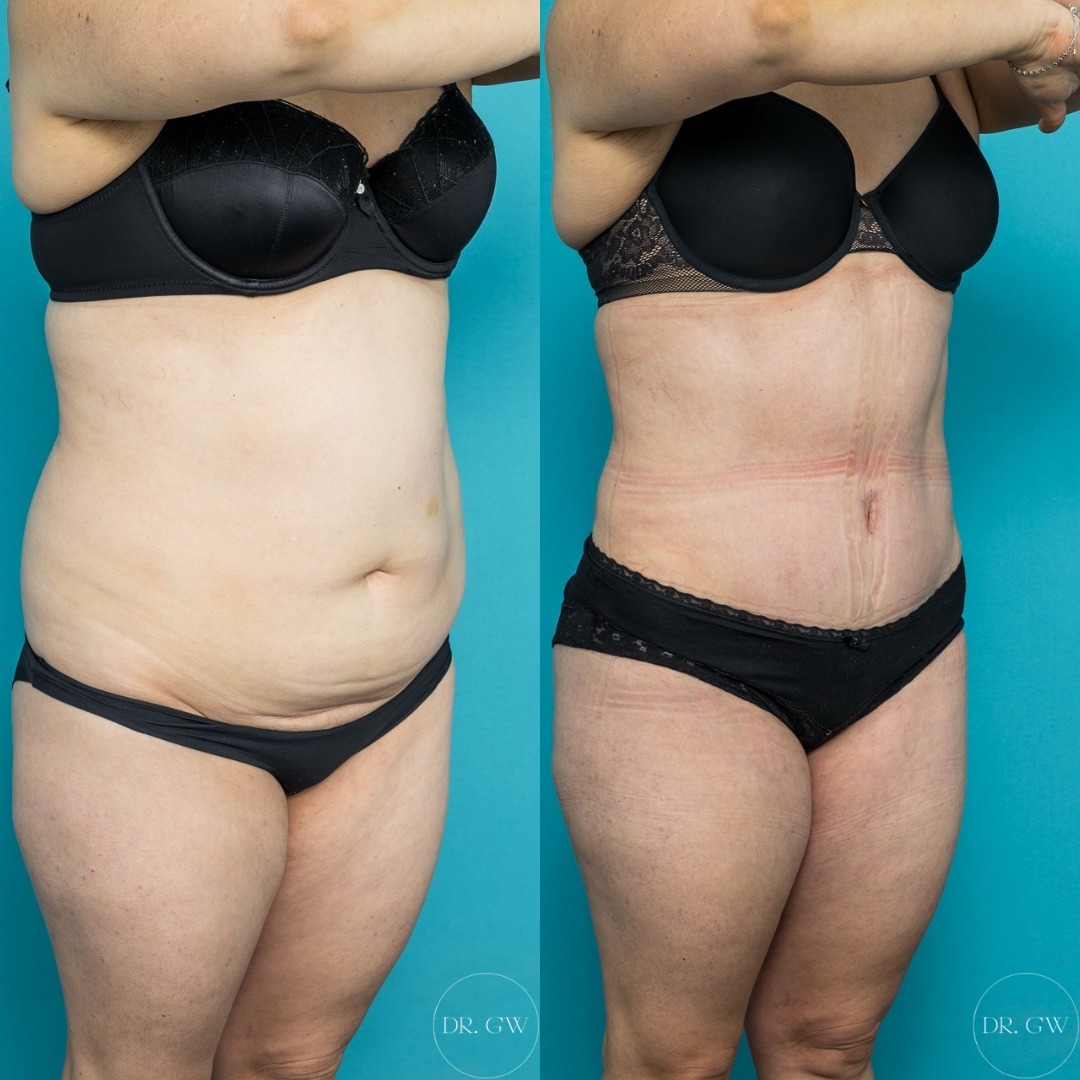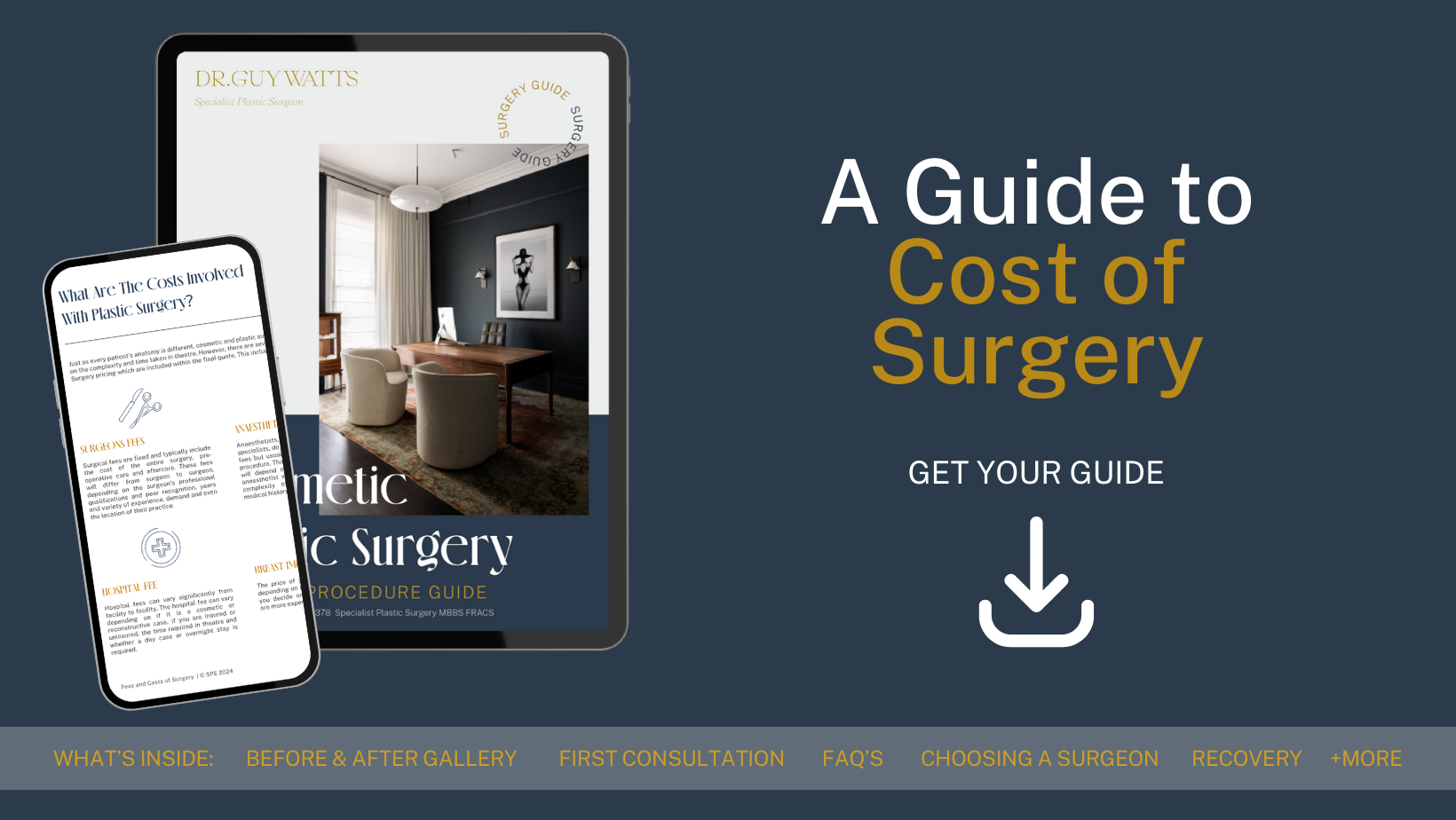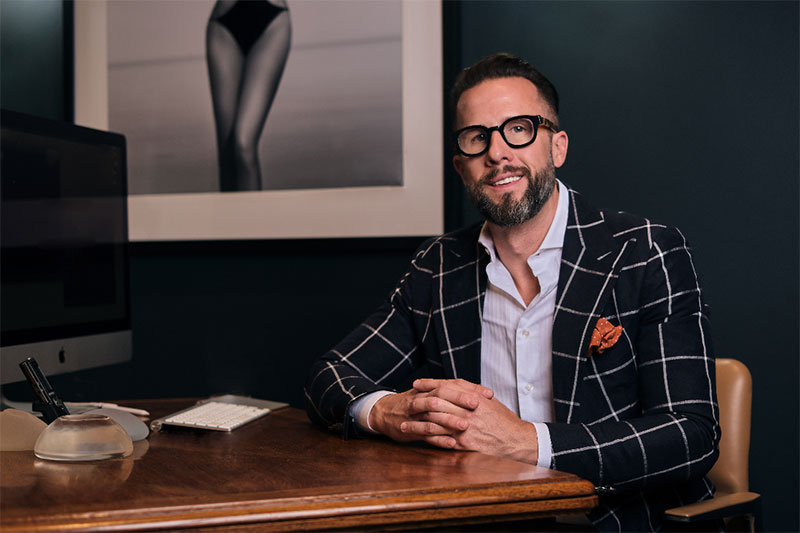
20 Dec Scar Management after Plastic Surgery
How to Reduce Plastic Surgery Scars
Scarring is an unavoidable consequence of the body’s healing process following any surgical intervention, including aesthetic plastic surgery procedures. While no scar can be completely eliminated, Dr. Guy Watts uses different techniques both during the operation and postoperatively to make sure scar visibility is as low as possible.
Perth Specialist Plastic Surgeon Dr. Guy Watts has many years of experience performing facial, breast and body procedures. If you’re still in the research phase, you might find our guide on considering plastic surgery in West Perth helpful in deciding if it’s right for you. He is committed to guiding his patients from the pre-operative consultation to the recovery period to achieve optimal results from their surgical intervention. Dr. Watts will go through some key principles of scar management and offer specific tips for procedures like abdominoplasty, breast augmentation, breast reduction, and facelift.
Take our quiz, and find out if you are ready for surgery
Surgical Technique and Scars
Proper scar management begins in the operating room with meticulous surgical technique. Using fine instruments and sutures, Dr. Watts aligns the wound edges to reduce tension and make a thin, uniform scar. Reducing tension is critical as scars tend to widen and thicken under tension. Where possible, he places incisions along skin creases or borders to camouflage them. For example:
- Abdominoplasty/tummy tuck incisions are placed in the bikini line
- Facelift incisions are placed around the ear and in the hairline
- Breast augmentation incisions are often placed in the inframammary fold
Dr. Watts avoids incisions that cut across skin tension lines, as they tend to heal more noticeably. In larger incisions like abdominoplasty, he places deep sutures to remove tension from the skin closure. Wound closure is performed in multiple layers, with absorbable sutures placed deeply to provide long-term support as the scar matures over several months.
Dressings and Incision Care
Immediately after surgery, incisions are covered with surgical tapes or a light dressing. Dr. Watts recommends keeping your incisions dry for the first 48 hours. After that, you can shower and lightly pat the incisions dry. Be sure not to soak your incisions in a bath or pool until they are fully healed.
In most cases, any non-absorbable stitches are removed after 1-2 weeks. Dr. Watts then recommends applying a silicone-based scar gel or silicone sheets to your scars.
Potential Benefits of Silicone-Based Scar Treatments
Silicone-based scar treatments, including silicone gels, sheets, and strips, have become a gold standard in topical scar management. They are widely recommended by plastic surgeons and dermatologists for their proven efficacy in alleviating the appearance and symptomatology of scars. Here’s a closer look at the potential benefits of silicone for scar healing:
Hydration
Silicone makes a semi-occlusive barrier over the scar, preventing transepidermal water loss. This keeps the scar hydrated, which is essential for optimal collagen remodelling and scar maturation. Well-hydrated scars are typically softer, flatter, and more pliable than dry scars.
Collagen regulation
Silicone has been shown to regulate fibroblast production of collagen. Fibroblasts are the cells responsible for producing collagen during wound healing. By stabilising collagen production, silicone can help prevent excessive collagen buildup that leads to raised, hypertrophic scars.
Reduced inflammation
Scars, especially in the early stages, can be inflamed, red, and itchy. Silicone has been shown to reduce inflammation in scars, which can alleviate symptoms like itching and discomfort. By reducing inflammation, silicone may also reduce scar discolouration.
Scar texture
With consistent use, silicone can help soften and flatten raised scars. This is likely due to its hydrating effects and its ability to regulate collagen production. Many patients report significant changes in scar texture with silicone use.
Non-invasive
Unlike some scar treatments that involve injections or surgery, silicone-based products are non-invasive. They are also generally well-tolerated, with very few risks of side effects. This makes silicone a suitable option for patients who prefer a non-invasive approach to scar management.
Use
Silicone gels and sheets can be applied and worn under clothing. Most products are applied twice daily, making them convenient to incorporate into your daily routine. Silicone sheets can also be washed and reused, making them a cost-effective option for long-term scar management.
To maximise the potential benefits of silicone, it’s important to use it consistently. Dr. Watts recommends using silicone-based products for at least 2-3 months for optimal results. It’s also essential to start silicone treatment early, ideally as soon as your incisions have fully healed (typically around 2 weeks post-op).
Silicone can be beneficial for most scar types, but it may not be suitable for every patient. Some people may experience skin irritation or rashes from silicone products. If you notice any adverse reactions, discontinue use and consult with Dr. Watts. He can recommend alternative scar management options that may be more suitable for your skin.
Alternative Treatments for Scar Management
If you find that silicone-based scar treatments are not providing the results you desire, or if you experience skin irritation from silicone products, there are several alternative scar management options available. Dr. Watts can work with you to develop a personalised treatment plan based on your specific scar type, skin type, and preferences. Here are some alternative treatments for post-surgical scars:
Pressure therapy
Pressure garments or tapes apply continuous pressure to the scar, which can help flatten and soften raised scars. This type of therapy is often used for larger scars, such as those from abdominoplasty or breast surgery. Dr. Watts may recommend wearing a custom-fitted pressure garment for 23 hours per day for several months.
Topical scar creams
There are many over-the-counter and prescription scar creams available that can help alleviate the appearance of scars. Some active ingredients include Vitamin E (moisturises and softens scars), Vitamin C (works on scar discolouration and promotes collagen production), onion extract (has anti-inflammatory and anti-microbial properties) and hydroquinone (lightens hyper pigmented scars). Dr. Watts can recommend a scar cream that is suitable for your skin type and scar type.
Intralesional steroid shots
For raised, hypertrophic scars that are not responding to topical treatments, Dr. Watts may recommend intralesional steroid shots. These deliver a high concentration of corticosteroid directly into the scar, which can help flatten and soften the scar tissue. These are typically repeated every 4-6 weeks until satisfactory changes are achieved.
Laser therapy
Several types of lasers can be used to alleviate the scars appearance, including pulsed dye lasers (PDL), fractional CO2 lasers, and erbium: YAG lasers. These lasers work by targeting blood vessels (in the case of PDL) or by making microscopic wounds in the scar tissue to stimulate collagen remodeling (in the case of CO2 and erbium: YAG lasers). Laser treatments are typically performed in a series of 3-6 sessions, spaced 4-6 weeks apart.
Microneedling
Microneedling involves using a device with fine needles to make microchannels in the skin. This stimulates collagen production and can help alleviate scar texture and appearance. Microneedling can be performed with a dermaroller or an automated microneedling device. Dr. Watts may recommend a series of 3-6 treatments, spaced 4-6 weeks apart, for optimal results.
Surgical scar revision
For severe scars that are not responding to non-surgical treatments, surgical scar revision may be an option. This involves surgically removing the scar tissue and re-closing the incision with advanced wound closure techniques to reduce scar formation. Dr. Watts will only recommend surgical scar revision if he believes it will provide a significant change over non-surgical options.
You should know that scar healing is a gradual process, and it can take several months to see the full results of any scar treatment. Dr. Watts asks his patients to be patient and consistent with their scar management routine. He also recommends using multiple scar therapies for optimal results. For example, you might use a topical scar cream in conjunction with laser treatments or microneedling.
Sun Protection
Sun exposure can cause scars to darken permanently, making them more noticeable. It’s important to protect your scars from the sun, especially in the first year after surgery. Dr. Watts recommends covering your scars with clothing or applying a broad-spectrum sunscreen with SPF 30 or higher whenever your scars may be exposed. This is especially important in sun-intensive locations like Perth.
Massage and Moisturising
Once your incisions have fully healed, usually after 3-4 weeks, Dr. Watts recommends lightly massaging your scars. Massage can help soften and desensitise the scar tissue. Use the pads of your fingers and massage in a firm circular motion for 5-10 minutes, 2-3 times per day. You can use a moisturising lotion or oil to lubricate the skin during massage.
In addition to massage, keeping your scars well-moisturised can prevent dryness and irritation that may lead to itching and scar darkening. Use a fragrance-free, non-comedogenic moisturiser twice daily.
Recommendations for Specific Procedures
Abdominoplasty/Tummy Tuck
- Wear a supportive abdominal binder for the first 6 weeks to offload tension on your scar
- Avoid twisting movements or lifting more than 5kg during your recovery to prevent excessive tension on your scar
- Sleep with a pillow under your knees for the first week to avoid straining your incision
Breast Augmentation/Breast Reduction
- Wear a supportive surgical bra 24/7 for the first 6 weeks to reduce tension on your scars
- Avoid underwire bras for at least 8 weeks after surgery
- Sleep on your back and avoid side-lying positions that may put pressure on your scars
Facelift
- Keep your head elevated, even during sleep, for the first 2 weeks to reduce swelling and tension on your scars
- Avoid bending forward or lifting heavy objects for 4 weeks
- Use a light touch when cleansing your face and applying skincare products around your incisions
DOWNLOAD DR WATTS’ GUIDE TO COST OF SURGERY

FAQs about Scar Management after Plastic Surgery
How soon after surgery can I start scar treatment?
- It’s important to wait until your incisions have fully healed before beginning any scar treatment. This typically takes around 2-3 weeks, but can vary depending on the type of surgery and your individual healing process.
- Dr. Watts will assess your incisions during your follow-up appointments and let you know when it’s okay to start scar management.
- Starting too early can irritate your incisions and disrupt the healing process, so it’s important to follow Dr. Watts’ guidance.
Can I use makeup to conceal my scars while they’re healing?
- If your scars are on your face, you may be eager to conceal them with makeup. However, you should avoid applying makeup directly on your incisions until they have healed, usually after 2-3 weeks.
- Once your incisions have healed, you can use a non-comedogenic, fragrance-free concealer to camouflage your scars.
- Be sure to remove all makeup carefully and thoroughly at the end of the day to prevent irritation and breakouts. If you’re unsure about which makeup products are okay to use, consult with Dr. Watts or his team.
Can I use multiple scar treatments?
- Yes, using multiple scar therapies can often lead to more optimal results compared to using just one treatment alone. For example, you might use a topical silicone gel in conjunction with pressure therapy, or alternate between laser treatments and microneedling.
- Dr. Watts can help you develop a personalised scar management plan that incorporates multiple therapies for optimal results. However, it’s important not to overdo it – using too many treatments at once can irritate your skin and potentially worsen your scars.
- Always follow Dr. Watts’ guidance and allow adequate time between treatments.
How long does it take for scars to fully mature?
- Scars can take up to 12-18 months to fully mature. During this time, your scars may undergo significant changes in appearance.
- Initially, scars are often red, raised, and firm. Over time, they typically become flatter, softer, and more closely resemble your skin colour. However, some scars may remain slightly discoloured or textured even after they have fully matured.
- While scar treatments can significantly alter the appearance of your scars, it’s important to have realistic expectations.
- Scars are an expected part of the healing process and will never completely disappear.
Are there any lifestyle changes I can make to help my scar healing?
- Yes, certain lifestyle factors can influence how your scars heal.
- Eating a balanced diet rich in vitamins and minerals can provide your body with the nutrients it needs for optimal healing.
- Staying hydrated by drinking plenty of water can also help keep your skin moisturised and supple.
- If you smoke, quitting or cutting back can increase your circulation and promote scar healing.
- Finally, managing stress through techniques like meditation, yoga, or deep breathing can help reduce inflammation in your body and support the healing process.
- While lifestyle changes alone won’t eliminate your scars, they can make a supportive environment for optimal scar healing.
Further Reading about Surgery with Perth Specialist Plastic Surgeon Dr. Guy Watts
- Read Dr. Watts’ Blog about Stop Smoking for Plastic Surgery
- Read Dr. Watts’ Blog about Potential Benefits of Wearing Compression Garments after Abdominoplasty
- Read Dr. Watts’ Blog about Top 10 Methods to Reduce Scars after Breast Reduction Surgery
- Read Dr. Watts’ Recovery after Surgery Page
- Read Dr. Watts’ Lose Weight before Plastic Surgery Page
Medical References for Scar Management after Plastic Surgery
About Dr. Guy Watts – MED0001539378
FRACS (Plas) – Specialist Plastic Surgeon In Perth WA
Dr. Guy Watts is a Specialist Plastic Surgeon (AHPRA MED0001539378) with an extensive career that spans across renowned plastic surgery clinics worldwide. His experience has been honed through invaluable experiences at esteemed establishments such as the New York Eye and Ear Infirmary and the renowned Pitanguy Clinic in Brazil.
Having collaborated with the foremost cosmetic plastic surgeons on a global scale, Dr. Watts has chosen to return to Perth after a 17-year journey of intensive training and invaluable professional experience to bring the latest practices and technology in cosmetic plastic surgery to his patients.
Dr. Watts is a Fellow of the Royal Australasian College of Surgeons (FRACS) and a Member of the Australian Society of Plastic Surgeons (ASPS), Australasian Society of Aesthetic Plastic Surgeons (ASAPS) and the International Society of Aesthetic Plastic Surgeons (ISAPS).
Read about the potential Risks and Complications of Surgery
Read the Patient Information and Resources
About CLINISPA
Clinispa is Dr Watts’ bespoke medical clinic performing Cosmetic Aesthetic treatments. At Clinispa, we offer advanced clinical treatments in a luxurious and calming environment, tailored to support your skin’s health and appearance.
Clinispa aesthetic services are performed by Dr Guy Watts’ nursing professionals, who have a passion for and solid understanding of facial aesthetics.
All Clinispa clients are considered individually, with a personalised treatment plan consisting of advanced scientific approaches to cosmetic aesthetics. We incorporate innovative technologies in conjunction with superiorly formulated skin care.
For more information about the full range of Clinispa Aesthetic of Cosmetic Treatments visit the Clinispa website








Sorry, the comment form is closed at this time.